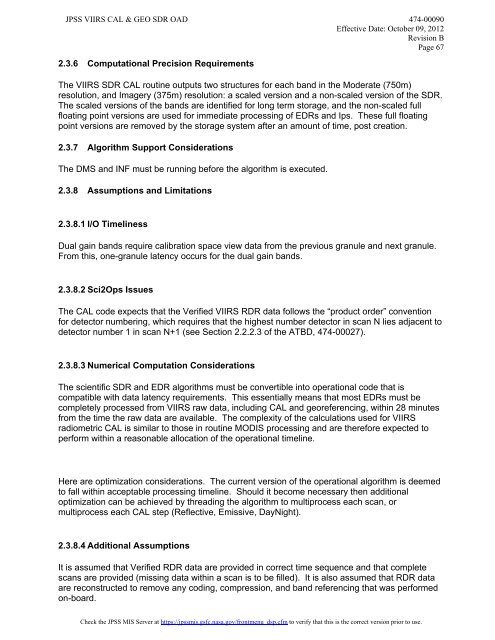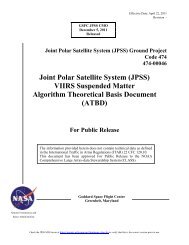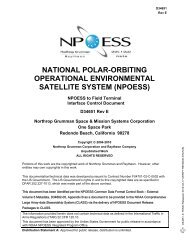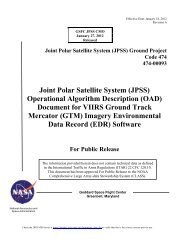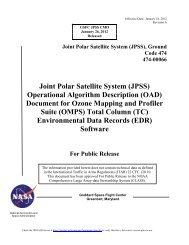VIIRS Geolocation (GEO) Sensor Data Record (SDR) - Nasa
VIIRS Geolocation (GEO) Sensor Data Record (SDR) - Nasa
VIIRS Geolocation (GEO) Sensor Data Record (SDR) - Nasa
Create successful ePaper yourself
Turn your PDF publications into a flip-book with our unique Google optimized e-Paper software.
JPSS <strong>VIIRS</strong> CAL & <strong>GEO</strong> <strong>SDR</strong> OAD 474-00090<br />
Effective Date: October 09, 2012<br />
Revision B<br />
Page 67<br />
2.3.6 Computational Precision Requirements<br />
The <strong>VIIRS</strong> <strong>SDR</strong> CAL routine outputs two structures for each band in the Moderate (750m)<br />
resolution, and Imagery (375m) resolution: a scaled version and a non-scaled version of the <strong>SDR</strong>.<br />
The scaled versions of the bands are identified for long term storage, and the non-scaled full<br />
floating point versions are used for immediate processing of EDRs and Ips. These full floating<br />
point versions are removed by the storage system after an amount of time, post creation.<br />
2.3.7 Algorithm Support Considerations<br />
The DMS and INF must be running before the algorithm is executed.<br />
2.3.8 Assumptions and Limitations<br />
2.3.8.1 I/O Timeliness<br />
Dual gain bands require calibration space view data from the previous granule and next granule.<br />
From this, one-granule latency occurs for the dual gain bands.<br />
2.3.8.2 Sci2Ops Issues<br />
The CAL code expects that the Verified <strong>VIIRS</strong> RDR data follows the “product order” convention<br />
for detector numbering, which requires that the highest number detector in scan N lies adjacent to<br />
detector number 1 in scan N+1 (see Section 2.2.2.3 of the ATBD, 474-00027).<br />
2.3.8.3 Numerical Computation Considerations<br />
The scientific <strong>SDR</strong> and EDR algorithms must be convertible into operational code that is<br />
compatible with data latency requirements. This essentially means that most EDRs must be<br />
completely processed from <strong>VIIRS</strong> raw data, including CAL and georeferencing, within 28 minutes<br />
from the time the raw data are available. The complexity of the calculations used for <strong>VIIRS</strong><br />
radiometric CAL is similar to those in routine MODIS processing and are therefore expected to<br />
perform within a reasonable allocation of the operational timeline.<br />
Here are optimization considerations. The current version of the operational algorithm is deemed<br />
to fall within acceptable processing timeline. Should it become necessary then additional<br />
optimization can be achieved by threading the algorithm to multiprocess each scan, or<br />
multiprocess each CAL step (Reflective, Emissive, DayNight).<br />
2.3.8.4 Additional Assumptions<br />
It is assumed that Verified RDR data are provided in correct time sequence and that complete<br />
scans are provided (missing data within a scan is to be filled). It is also assumed that RDR data<br />
are reconstructed to remove any coding, compression, and band referencing that was performed<br />
on-board.<br />
Check the JPSS MIS Server at https://jpssmis.gsfc.nasa.gov/frontmenu_dsp.cfm to verify that this is the correct version prior to use.


